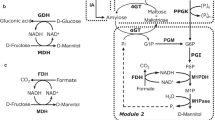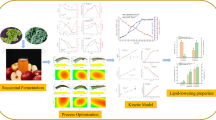Abstract
Mannitol is a natural low-calorie sugar alcohol produced by certain (micro)organisms applicable in foods for diabetics due to its zero glycemic index. In this work, we evaluated mannitol production and yield by the fruit origin strain Fructobacillus tropaeoli CRL 2034 using response surface methodology with central composite design (CCD) as optimization strategy. The effect of the total saccharide (glucose + fructose, 1:2) content (TSC) in the medium (75, 100, 150, 200, and 225 g/l) and stirring (S; 50, 100, 200, 300 and 350 rpm) on mannitol production and yield by this strain was evaluated by using a 22 full-factorial CCD with 4 axial points (α = 1.5) and four replications of the center point, leading to 12 random experimental runs. Fermentations were carried out at 30 °C and pH 5.0 for 24 h. Minitab-15 software was used for experimental design and data analyses. The multiple response prediction analysis established 165 g/l of TSC and 200 rpm of S as optimal culture conditions to reach 85.03 g/l [95% CI (78.68, 91.39)] of mannitol and a yield of 82.02% [95% CI (71.98, 92.06)]. Finally, a validation experiment was conducted at the predicted optimum levels. The results obtained were 81.91 g/l of mannitol with a yield of 77.47% in outstanding agreement with the expected values. The mannitol 2-dehydrogenase enzyme activity was determined with 4.6–4.9 U/mg as the highest value found. To conclude, F. tropaeoli CRL 2034 produced high amounts of high-quality mannitol from fructose, being an excellent candidate for this polyol production.






Similar content being viewed by others
References
Antunes A, Rainey FA, Nobre MF, Schumann P, Ferreira AM, Ramos A, Santos H (2002) Leuconostoc ficulneum sp. nov., a novel lactic acid bacterium isolated from a ripe fig, and reclassification of Lactobacillus fructosus as Leuconostoc fructosum comb. nov. Int J Syst Evol Microbiol 52(2):647–655
Betiku E, Emeko HA, Solomon BO (2016) Fermentation parameter optimization of microbial oxalic acid production from cashew apple juice. Heliyon 2(2):e00082
Brzozowski B, Lewandowska M (2014) Prolyl endopeptidase-optimization of medium and culture conditions for enhanced production by Lactobacillus acidophilus. Electron J Biotechnol 17(5):204–210
Camu N, De Winter T, Verbrugghe K, Cleenwerck I, Vandamme P, Takrama JS, Vancanneyt M, De Vuyst L (2007) Dynamics and biodiversity of populations of lactic acid bacteria and acetic acid bacteria involved in spontaneous heap fermentation of cocoa beans in Ghana. Appl Environ Microbiol 73(6):1809–1824
Carvalheiro F, Moniz P, Duarte LC, Esteves MP, Gírio FM (2011) Mannitol production by lactic acid bacteria grown in supplemented carob syrup. J Ind Microbiol Biotechnol 38(1):221–227
Chambel L, Chelo IM, Zé-Zé L, Pedro LG, Santos MA, Tenreiro R (2006) Leuconostoc pseudoficulneum sp. nov., isolated from a ripe fig. Int J Syst Evol Micrbiol 56(6):1375–1381
Chaturvedi V, Bartiss A, Wong B (1997) Expression of bacterial mtlD in Saccharomyces cerevisiae results in mannitol synthesis and protects a glycerol-defective mutant from high-salt and oxidative stress. J Bacteriol 179(1):157–162
Company TCR (1967) 1968 Handbook of chemistry and physics, 48th edition edn. The Chemical Rubber Company, Cleveland, Ohio
De Man J, Rogosa D, Sharpe ME (1960) A medium for the cultivation of lactobacilli. J Appl Bacteriol 23(1):130–135
de Olmos AR, Bru E, Garro M (2015) Optimization of fermentation parameters to study the behavior of selected lactic cultures on soy solid state fermentation. Int J Food Microbiol 196:16–23
Edwards U, Rogall T, Blöcker H, Emde M, Böttger EC (1989) Isolation and direct complete nucleotide determination of entire genes. Characterization of a gene coding for 16S ribosomal RNA. Nucleic Acids Res 17(19):7843–7853
Endo A (2012) Fructophilic lactic acid bacteria inhabit fructose-rich niches in nature. Microb Ecol Health Dis 23:10.3402
Endo A, Okada S (2008) Reclassification of the genus Leuconostoc and proposals of Fructobacillus fructosus gen. nov., comb. nov., Fructobacillus durionis comb. nov., Fructobacillus ficulneus comb. nov. and Fructobacillus pseudoficulneus comb. nov. Int J Syst Evol Microbiol 58(9):2195–2205
Endo A, Salminen S (2013) Honeybees and beehives are rich sources for fructophilic lactic acid bacteria. Syst Appl Microbiol 36(6):444–448
Endo A, Futagawa-Endo Y, Dicks LM (2009) Isolation and characterization of fructophilic lactic acid bacteria from fructose-rich niches. Syst Appl Microbiol 32(8):593–600. doi:10.1016/j.syapm.2009.08.002
Endo A, Irisawa T, Futagawa-Endo Y, Sonomoto K, Itoh K, Takano K, Okada S, Dicks LM (2011) Fructobacillus tropaeoli sp. nov., a fructophilic lactic acid bacterium isolated from a flower. Int J Syst Evol Micrbiol 61(4):898–902
Endo A, Tanaka N, Oikawa Y, Okada S, Dicks L (2014) Fructophilic characteristics of Fructobacillus spp. may be due to the absence of an alcohol/acetaldehyde dehydrogenase gene (adhE). Curr Microbiol 68(4):531–535
Felis GE, Salvetti S, Torriani S (2015) Systematics of lactic acid bacteria: current status, 2nd edn. Wiley Blackwell, Oxford
Fontes CP, Honorato TL, Rabelo MC, Rodrigues S (2009) Kinetic study of mannitol production using cashew apple juice as substrate. Bioprocess Biosyst Eng 32(4):493–499
Gaspar P, Carvalho AL, Vinga S, Santos H, Neves AR (2013) From physiology to systems metabolic engineering for the production of biochemicals by lactic acid bacteria. Biotechnol Adv 31(6):764–788
Hassaïne O, Zadi-Karam H, Karam N-E (2014) Statistical optimization of lactic acid production by Lactococcus lactis strain, using the central composite experimental design. Afr J Biotechnol 13(45)
He H, Chen Y, Zhang Y, Wei C (2011) Bacteria associated with gut lumen of Camponotus japonicus Mayr. Environ Entomol 40(6):1405–1409
Kets EP, Galinski EA, De Wit M, De Bont JA, Heipieper HJ (1996) Mannitol, a novel bacterial compatible solute in Pseudomonas putida S12. J Bacteriol 178(23):6665–6670
Koch H, Schmid-Hempel P (2011) Bacterial communities in central European bumblebees: low diversity and high specificity. Microb Ecol 62(1):121–133
Kodama R (1956) Studies on the nutrition of lactic acid bacteria. Part IV. Lactobacillus fructosus nov. sp., a new species of lactic acid bacteria. J Agric Chem Soc Jpn 30:705–708
LeBlanc JG, Laino JE, del Valle MJ, Vannini V, Van Sinderen D, Taranto MP, de Valdez G, de Giori GS, Sesma F (2011) B-group vitamin production by lactic acid bacteria–current knowledge and potential applications. J Appl Microbiol 111(6):1297–1309
Leisner JJ, Vancanneyt M, Van der Meulen R, Lefebvre K, Engelbeen K, Hoste B, Laursen B, Bay L, Rusul G, De Vuyst L (2005) Leuconostoc durionis sp. nov., a heterofermenter with no detectable gas production from glucose. Int J Syst Evol Microbiol 55(3):1267–1270
Li H, Cao Y (2010) Lactic acid bacterial cell factories for gamma-aminobutyric acid. Amino Acids 39(5):1107–1116
Lim C, Rahim R, Ho Y, Arbakariya B (2007) Optimization of growth medium for efficient cultivation of Lactobacillus salivarius i 24 using response surface method. Malays J Microbiol 3(2):41–47
Makhija LK, Jha MK, Bhattacharya S, Rai A, Dey AB, Saha A (2011) Transverse facial cleft: a series of 17 cases. Indian J Plast Surg 44(3):439–443. doi:10.4103/0970-0358.90815
Manochai P, Phimolsiripol Y, Seesuriyachan P (2014) Response surface optimization of exopolysaccharide production from sugarcane juice by Lactobacillus confusus TISTR 1498. CMU J Nat Sci 13(1):425–438. doi:10.12982/CMUJNS.2014.0046
Ortiz ME, Fornaguera MJ, Raya RR, Mozzi F (2012) Lactobacillus reuteri CRL 1101 highly produces mannitol from sugarcane molasses as carbon source. Appl Microbiol Biotechnol 95(4):991–999
Ortiz ME, Bleckwedel J, Raya RR, Mozzi F (2013) Biotechnological and in situ food production of polyols by lactic acid bacteria. Appl Microbiol Biotechnol 97(11):4713–4726
Ortiz ME, Raya RR, Mozzi F (2015) Efficient mannitol production by wild-type Lactobacillus reuteri CRL 1101 is attained at constant pH using a simplified culture medium. Appl Microbiol Biotechnol 99(20):8717–8729
Ortiz ME, Bleckwedel J, Fadda S, Picariello G, Hebert EM, Raya RR, Mozzi F (2017) Global analysis of mannitol 2-dehydrogenase in Lactobacillus reuteri CRL 1101 during mannitol production through enzymatic, genetic and proteomic approaches. PLoS One 12(1):e0169441
Price CE, Zeyniyev A, Kuipers OP, Kok J (2012) From meadows to milk to mucosa–adaptation of Streptococcus and Lactococcus species to their nutritional environments. FEMS Microbiol Rev 36(5):949–971
Rodríguez C, Rimaux T, Fornaguera MJ, Vrancken G, de Valdez GF, De Vuyst L, Mozzi F (2012) Mannitol production by heterofermentative Lactobacillus reuteri CRL 1101 and Lactobacillus fermentum CRL 573 in free and controlled pH batch fermentations. Appl Microbiol Biotechnol 93(6):2519–2527
Rokop Z, Horton M, Newton I (2015) Interactions between cooccurring lactic acid bacteria in honey bee hives. Appl Environ Microbiol 81(20):7261–7270
Saha BC (2006) Effect of salt nutrients on mannitol production by Lactobacillus intermedius NRRL B-3693. J Ind Microbiol Biotechnol 33(10):887–890
Saha BC, Nakamura LK (2003) Production of mannitol and lactic acid by fermentation with Lactobacillus intermedius NRRL B-3693. Biotechnol Bioeng 82(7):864–871
Sand M, Rodrigues M, González JM, Crécy-Lagard V, Santos H, Müller V, Averhoff B (2015) Mannitol-1-phosphate dehydrogenases/phosphatases: a family of novel bifunctional enzymes for bacterial adaptation to osmotic stress. Environ Microbiol 17(3):711–719
Snauwaert I, Papalexandratou Z, De Vuyst L, Vandamme P (2013) Characterization of strains of Weissella fabalis sp. nov. and Fructobacillus tropaeoli from spontaneous cocoa bean fermentations. Int J Syst Evol Microbiol 63(5):1709–1716
Thaochan N, Drew RAI, Hughes J, Vijaysegaran S, Chinajariyawong A (2010) Alimentary tract bacteria isolated and identified with API-20E and molecular cloning techniques from Australian tropical fruit flies, Bactrocera cacuminata and B. tryoni. Int J Insect Sci 10(1):131
Versalovic J, Schneider M, De Bruijn FJ, Lupski JR (1994) Genomic fingerprinting of bacteria using repetitive sequence-based polymerase chain reaction. Methods Mol Cell Biol 5(1):25–40
von Weymarn N, Hujanen M, Leisola M (2002a) Production of D-mannitol by heterofermentative lactic acid bacteria. Process Biochem 37(11):1207–1213
von Weymarn N, Kiviharju K, Leisola M (2002b) High-level production of D-mannitol with membrane cell-recycle bioreactor. J Ind Microbiol Biotechnol 29(1):44–49
Wisselink H, Weusthuis R, Eggink G, Hugenholtz J, Grobben G (2002) Mannitol production by lactic acid bacteria: a review. Int Dairy J 12(2):151–161
Yun JW, Kim DH (1998) A comparative study of mannitol production by two lactic acid bacteria. J Biosci Bioeng 85(2):203–208
Acknowledgements
We are grateful to Prof. Dr. César Catalán from the Universidad Nacional de Tucumán for equipment supply and assistance during the melting temperature determination of mannitol crystals.
Author information
Authors and Affiliations
Corresponding author
Ethics declarations
Ethical approval
This article does not contain any studies with human participants or animals performed by any of the authors.
Conflict of interest
The authors declare that they have no competing interests.
Funding
The study received support from the Consejo Nacional de Investigaciones Científicas y Técnicas (CONICET, PIP 003) and Fondo para la Investigación Científica y Tecnológica (FONCyT, Préstamo BID PICT 2014-312) from Argentina; the Tallin University of Technology, Estonia, for awarding KA the internship scholarship to work in CERELA; and the Belgian Argentinean Fermented Foods (BAFF) project from the Vrije Universiteit Brussel, Belgium. LRR is recipient of a doctoral fellowship from CONICET.
Rights and permissions
About this article
Cite this article
Ruiz Rodríguez, L.G., Aller, K., Bru, E. et al. Enhanced mannitol biosynthesis by the fruit origin strain Fructobacillus tropaeoli CRL 2034. Appl Microbiol Biotechnol 101, 6165–6177 (2017). https://doi.org/10.1007/s00253-017-8395-1
Received:
Revised:
Accepted:
Published:
Issue Date:
DOI: https://doi.org/10.1007/s00253-017-8395-1




